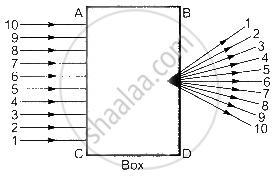Advertisements
Advertisements
प्रश्न
If the object is moved to a point only 3 cm away from the lens, what is the new position, height and nature of the image?
उत्तर
Object distance (u) =-3
`1/f=1/v-1/u`
⇒`1/8=1/v-1/-3`
⇒`1/8=1/v+1/3`
⇒`1/8-1/3=1/v`
⇒`(3-8)/24=1/v`
⇒`-5/24=1/
⇒`v=-24/5`
⇒`v=-4.8`cm
The image will be at a distance of 4.8 cm in front of the lens.
Magnification `(m) v/u`
⇒ `m=(-4.8)/-3`
⇒m=1.6
Positive value of magnifiction shows that the image is virtual and erect.
`m=h_i/h_o`
⇒`1.6=h_i/3`
⇒`h_i=3xx1.6=4.8` cm
positive sign of the image shows that the image will be formed above the principal axis.
APPEARS IN
संबंधित प्रश्न
Where should an object be placed so that a real and inverted image of the same size as the object is obtained using a convex lens?
An object is placed at a distance of 12 cm from a convex lens of focal length 8 cm. Find :
1) the position of the image
2) nature of the image
Distinguish between a convex lens and concave lens. Which of the two is a converging lens : convex lens of concave lens?
What is the position of image when an object is placed at a distance of 10 cm from a convex lens of focal length 10 cm?
Find the nature, position and magnification of the images formed by a convex lens of focal length 0.20 m if the object is placed at a distance of:
0.50 m
Which part causes the greatest convergence?
A lens forms an inverted image of an object. Name the kind of lens.
In the following cases, where must an object be placed in front of a convex lens so that the image formed is at infinity?
Find the odd one out and give its explanation.
A beam of light is incident through the holes on side A and emerges out of the holes on the other face of the box as show in the figure. Which of the following could be inside the box?

